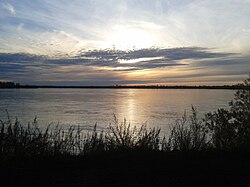This is an old revision of this page, as edited by Ground Zero (talk | contribs) at 13:07, 11 January 2011 (WP:BOLDFACE). The present address (URL) is a permanent link to this revision, which may differ significantly from the current revision.
Revision as of 13:07, 11 January 2011 by Ground Zero (talk | contribs) (WP:BOLDFACE)(diff) ← Previous revision | Latest revision (diff) | Newer revision → (diff) River| Kolyma | |
|---|---|
 | |
| Physical characteristics | |
| Mouth | East Siberian Sea |
| Length | 2,129 km |

The Kolyma River (Template:Lang-ru) is a river in northeastern Siberia, whose basin covers parts of the Sakha Republic, Chukotka Autonomous Okrug, and Magadan Oblast of Russia. It rises in the mountains north of Okhotsk and Magadan, in the area of 62°N 149°E / 62°N 149°E / 62; 149 and empties into the Kolyma Gulf (Kolymskiy Zaliv) of the East Siberian Sea, a division of the Arctic Ocean, at 69°30′N 161°30′E / 69.500°N 161.500°E / 69.500; 161.500. The Kolyma is 2,129 kilometres (1,323 mi) long. The area of its basin is 644,000 km².
The Kolyma is frozen to depths of several metres for about 250 days each year, becoming free of ice only in early June, until October.
History
In 1640 Dimitry Zyryan (also called Yarilo or Yerilo) went overland to the Indigirka. In 1641 he sailed down the Indigirka, went east and up the Alazeya. Here they heard of the Kolyma and met Chukchis for the first time. In 1643 he returned to the Indigirka, sent his yasak to Yakutsk and went back to the Alazeya. In 1645 he returned to the Lena where he met a party and learned that he had been appointed prekazshchik of the Kolyma. He returned east and died in early 1646. In the winter of 1641-42 Mikhail Stadukhin, accompanied by Semyon Dezhnyov, went overland to the upper Indigirka. He spent the next winter there, built boats and sailed down the Indigirka and east to the Alazeya where he met Zyryan. Zyrian and Dezhnev stayed at the Alazeya, while Stadukhin went east, reaching the Kolyma in the summer of 1644. They built a zimovye, probably at Srednekolymsk and returned to Yakutsk in late 1645.
In 1892-1894 Baron Eduard Von Toll carried out geological surveys in the basin of the Kolyma (among other Far-eastern Siberian rivers) on behalf of the Russian Academy of Sciences (Barr, 1980). During one year and two days the expedition covered 25,000 km, of which 4,200 km were up rivers, carrying out geodesic surveys en route.
The Kolyma is known for its Gulag labour camps and gold mining, both of which have been extensively documented since Joseph Stalin era Soviet archives opened. The river gives its title to a famous anthology about life in Gulag camps by Varlam Shalamov, The Kolyma Tales.
After the camps were closed, state subsidies, local industries and communication have dwindled to almost nothing. Many people have migrated, but those who remain in the area make a living by fishing and hunting.
Mouths of the Kolyma
In the last 75 km stretch the Kolyma divides into two large branches. There are many islands at the mouth of the Kolyma before it meets the East Siberian sea. The main ones are:
- Mikhalkino 69°24′58″N 161°15′18″E / 69.416°N 161.255°E / 69.416; 161.255 is the largest island, it lies to the west of the Kolyma's eastern branch, the Prot. Kammennaya Kolyma. This island breaks up into smaller islands on its northern end. It is 24 km long and 6 km wide. Mikhalkino is also known as "Glavsevmorput Island" after the Chief Directorate of the Northern Sea Route.
- Sukharnyy, or Sukhornyy , is located 3 km from the northeastern shores of Mikhalkino. It is 11 km long and about 5 km wide. Northeast of Sukhornyy lies a cluster of small islands known as the Morskiye Sotki Islands.
- Piat' Pal'tsev lies 5 km to the southeast of Sukhornyy's southern end. It is 5 km long and has a maximum width of 1.8 km.
- Nazarovsky Island 69°31′59″N 161°05′10″E / 69.533°N 161.086°E / 69.533; 161.086 lies on the western side of the Kolyma's western branch, the Prot. Pokhodskaya Kolyma, in an area where there are many small islands. It is 4.5 km long and 1.3 km wide.
- Shtormovoy Island 69°39′58″N 161°01′52″E / 69.666°N 161.031°E / 69.666; 161.031 lies offshore, about 10 km to the north of Nazarovsky Island. Shtormovoy is the northernmost island off the Mouths of the Kolyma. It is 4.3 km long and 1.5 km wide.
See also
The Kolyma article which provides additional information about the Gulag.
References
- Lantzeff, George V., and Richard A. Pierce (1973). Eastward to Empire: Exploration and Conquest on the Russian Open Frontier, to 1750. Montreal: McGill-Queen's U.P.
{{cite book}}: CS1 maint: multiple names: authors list (link)
General references
- William Barr, Baron Eduard von Toll’s Last Expedition: The Russian Polar Expedition, 1900-1903 (1980).
- Shalamov, Varlam Tikhonovich (1994) Kolyma tales , Glad, John (transl.), Penguin twentieth-century classics, Harmondsworth : Penguin, ISBN 0-14-018695-6
- Once-cursed Gulag river now Siberian lifeline:
- Strandberg, Mikael and Johan Ivarsson, travelled down the full length of the Kolyma River 2004. An Expedition hailed internationally as one of the coldest ever.
- Position and names of islands